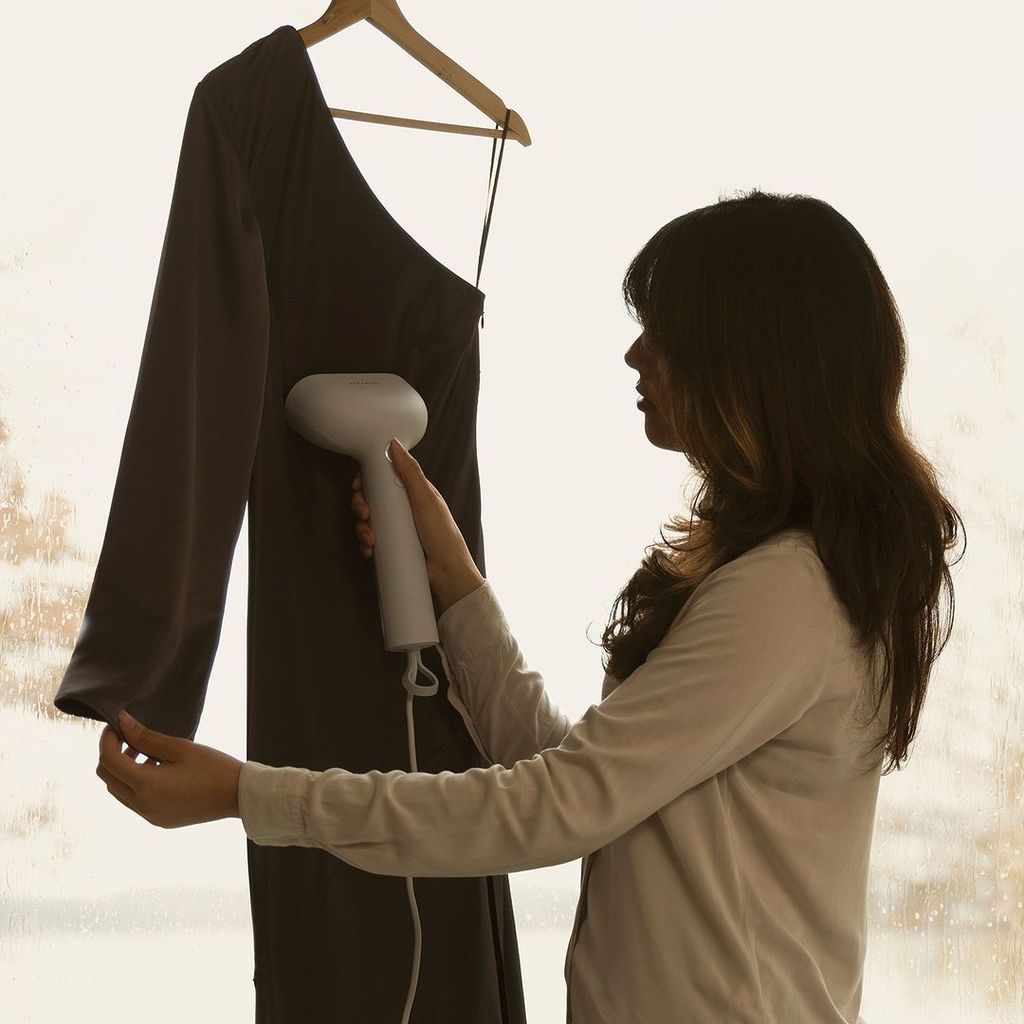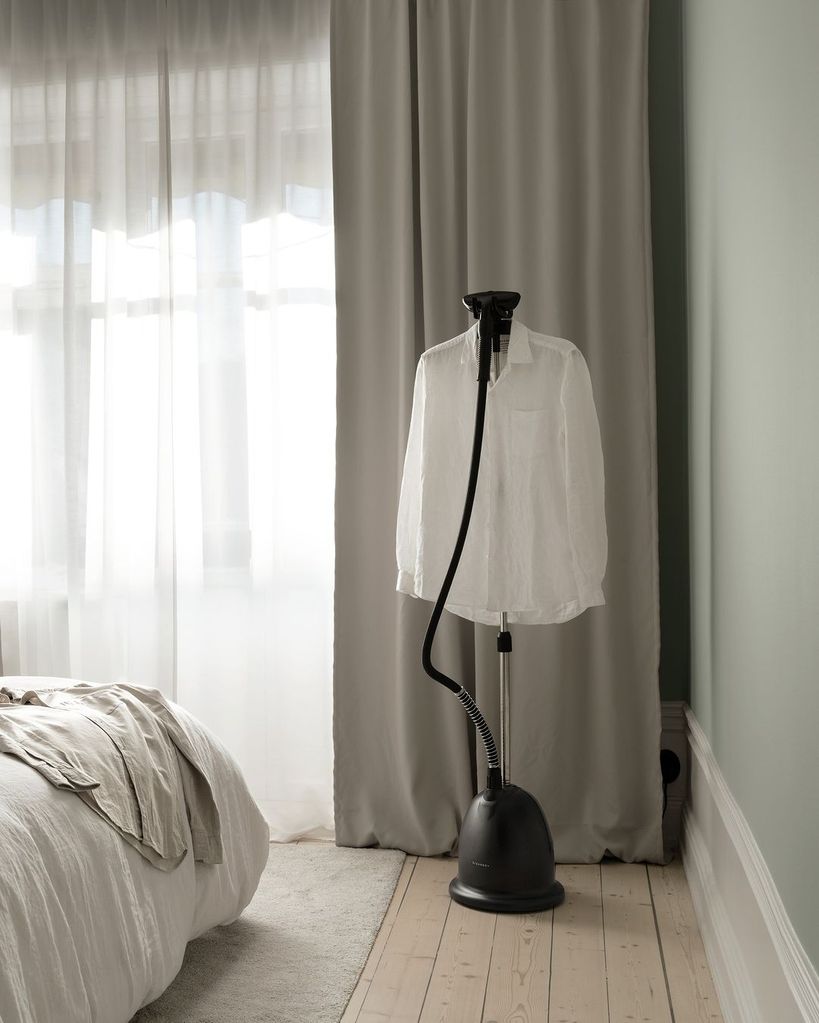When striving for a circular wardrobe, taking care of your clothes is essential. By properly caring for your clothes, you extend their lifespan and minimise the need for constant replacements.
“One of the biggest problems when it comes to the fashion industry today is textile waste. On average in Europe, we only use a piece of clothing 7– 8 times before throwing it away. Obviously, we can't continue like this,” a spokesperson for clothing tech company Steamery told Hello! Fashion, “By doubling a garment's lifespan, you reduce its greenhouse gas emission footprint by 50%. Therefore, we want to inspire people to care for, repair, and reuse their favourite garments repeatedly.”
"One of the biggest problems when it comes to the fashion industry today is textile waste. On average in Europe, we only use a piece of clothing 7– 8 times before throwing it away. Obviously, we can't continue like this.”
A wardrobe that’s ‘in good nick’ promotes sustainability by focusing on reducing, reusing, and recycling clothing items. Regularly washing and storing garments according to care instructions prevents unnecessary wear and tear, preserving their quality. Additionally, repairing, altering and upcycling items that need a little TLC allows you to continue enjoying them instead of discarding them prematurely.
"If you take proper care of your clothes by steaming between washes, mending them when broken and washing them the right way, they will last much longer so that you pass them on to a new owner," confirmed Steamery.
"If you take proper care of your clothes by steaming between washes, mending them when broken and washing them the right way, they will last much longer so that you pass them on to a new owner,"
The experts at Steamery gave us the lowdown on how to look after every item of clothing to make sure they last as long as possible:
What tips do you have for making clothes look fresh and new again?
"Wash less frequently and steam your clothes more, airing them outside overnight, using a fabric shaver to remove pilling, repairing when broken and spritzing with a fabric spray to give them a nice scent."
What is the best way to steam clothes?
"Steaming is pretty easy. Start with filling the water tank and plug in the steamer. The most common way to steam is to hang your garment on a hanger. Find a place where you can comfortably hang your garment with an electrical outlet nearby. For a professional result, grab the bottom hem of the garment and gently stretch the fabric while you are steaming. This makes it easier to eliminate tough creases. Once the steamer is producing steam, move the steamer against the fabric in any direction, top to bottom or sideways."
"The important thing is that you hold the steamer against the fabric. You can also steam from the inside of the garment. This is an effective technique for removing creases on button-up shirts, blouses, t-shirts, and similar garments. A heat-protected steaming tool can really come in handy when steaming details like collars, cuffs, and hems. Simply hold the tool behind the fabric while steaming to create a pressed effect."
How often should you wash your clothes?
"Depending on how often you use the garment and how close to your body you wear it, this tells how often you need to wash your clothes. Steaming your clothes between washes will prolong the lifespan of your clothes."
Is steaming clothes good for them? Does steaming clothes get rid of smell?
"Steaming serves multiple purposes, as the hot steam not only removes wrinkles but also fights unpleasant odours and bacteria. Since you do not have to wash your clothes as often when using a steamer, the lifespan of your garments gets extended."
"Steaming is ideal for delicate textiles like silk, velvet, and cashmere. A steamer is also a smart tool to use when travelling to quickly freshen up your clothes on the go."
Is it better to iron or steam clothes?
"It depends on the result you want to achieve. Ironing and steaming are two effective methods of removing wrinkles from your textiles. However, steaming is a gentler alternative, as the hot steam lifts and makes the textile fibres swell instead of pressing them down, which allows them to regain their natural shape. Steaming is also a much gentler way to de-wrinkle delicate fabrics like silk, and garments that cannot be ironed due to their shape or texture, like draped, pleated, or beaded items of clothing. If you want to both steam your clothes and in the same time create pressed details, our Iron Steamer is a gentler alternative."
What clothes can you not steam?
"You can steam all kinds of materials except for leather and suede."
Does steaming shrink clothes?
"No, rather the opposite. The hot steam makes the fibres swell and the fabric regains its usual shape. If you have washed garments made of viscose or similar materials these may shrink a bit from the heat and movement in the washing machine. Steaming these materials will make the fabric swell and get their shape back again."
Can you steam your jeans?
"Yes, steaming is a great alternative to washing jeans. Since denim is a material that shouldn’t be washed too often to prevent it from losing its shape and colour, steaming is an easy way to keep them fresh between washes."
Is a hand steamer worth it?
"Yes. If you want an easy tool for keeping your clothes wrinkle-free and fresh between washes and in the same way making them last longer – then we really recommend a handheld steamer. These are also neat and compact and easy to bring when travelling when you usually use a limited amount of clothes and don’t have access to a washing machine."
What should I bear in mind when travelling with a steamer?
"The number one thing to check before travelling with your steamer is the voltage and frequency standards of your travel destination. As a general guideline, European countries, along with most of Asia and Africa, use 220–240 V and 50 Hz, while North American countries use 120 V and 60 Hz as the standard voltage and frequency.
Hence, if you buy a steamer in Europe, it should not be used in North America. The next thing to do is to find out if you can use the same plug in your destination country. If the plug is different, you need to use a travel adapter. There are fifteen different plugs used across the globe, ranging from type A all the way to type O. To be clear, a travel adapter is useful only if the voltage and frequency are right. A travel adapter should not be confused with a voltage converter. But if the voltage and frequency of your destination are the same as where you bought your steamer, all you need to do is find a travel adapter with the right plug, and you’re good to go!"
How do I steam silk?
"When steaming silk, you should be a bit careful. You can steam your garment with a bit of distance to not harm the fabric with the heat from the front plate of the steamer. Some silk garments are more sensitive to water so make sure to read the care label before steaming the garment."
How do I remove and prevent pilling from clothes?
"To remove pilling from clothes we recommend using a fabric shaver. Pilling is small bobbles that appear on your knitted clothes and a reason why many garments are returned to the stores or thrown away. Pilling is excess fibres that travel to the surface of the garment. How much pilling a garment will attract depends on the quality and the features of the fabric: short textile fibres will generally pill more than longer fibres, and straight fibres will pill more than curly fibres. A new garment will pill more than old garment since new clothes have more excess fibres. Pilling is typically found where there is more abrasion – wear and tear – like for instance on cuffs or on the sides."
"When buying clothes start by reading the care label. There is a difference between synthetic pills and pills on natural fabrics. Synthetic pills are almost impossible to remove, while pills on natural fabrics are easily removed. All knitted garments containing acrylic will attract a lot of pilling, since acrylic is made of very short and very straight fibers. Acrylic may look nice on the store hanger, but it’s a fabric that doesn’t really age with dignity. Cashmere is among those natural fabrics that will pill quite a lot, but it’s not a sign of bad quality."
"A fabric shaver will cut off the pills. It’s both effective and gentle. By simply shaving off the pills with a fabric shaver, your textiles will appear as new again. Make sure to place your garment on a flat surface and gently swipe the nozzle over the fabric and you will get pill and lint-free clothes again."
8 Tips For Looking After Your Clothes According to Steamery:
1. Wash less – steam more
"The most common reason why clothes lose their shape or quality is because we wash them too often, or the wrong way. Steaming is a great alternative to washing; the hot steam not only leaves your clothes smooth, fresh and wrinkle-free but it also kills bacteria and reduces odours. This will keep your garments fresh in between washes."
2. Airing out your clothes
"We would also recommend airing your clothes outside overnight to remove odours and to make your garments feel fresh and crisp again."
3. Fabric spray
"You can also use a fabric spray to freshen up your clothes. Start with steaming your used garment, give them a spritz of fabric spray and they will be fresh and ready to be used again."
4. Stain removal
"If you get a stain on a garment, simply use a stain remover, and target the stain directly instead of washing the whole garment."
5. Wash right
"Not following the care label instructions is one of the biggest reasons why clothes get worn out quickly and end up in landfills. When washing your clothes, it’s important to use the right laundry products and techniques to prevent unnecessary wear and tear. Make sure to sort them carefully by colour to prevent colour bleeding and choose a gentle washing cycle on the machine. By lowering the temperature, you will make your clothes last longer. At Steamery, we offer laundry detergents that are effective even from 20°C. When drying your clothes, we recommend not to tumble dry anything except bed linen and towels. The gentlest way to dry your clothes is to air-dry."
6. Mending
"If your garments lose a button or get a broken hem, make sure to repair them. Usually fixing a hole or mending a hem isn’t that difficult. We’ve gathered our mending tutorials in one place so you can learn easy hacks that make your torn clothes feel wearable again. We also have a sewing kit to make it easier for you to mend your clothes at home."
7. De-bobbling
"It’s natural for pilling to occur on well-loved clothes, and it can be easily managed with a fabric shaver. Spruce up your knits and clothes by using a fabric shaver to remove all pilling."
8. Brushing
"Use a lint brush to keep your clothes free from hair, dust, fuzz and dandruff. It’s a sustainable alternative to the tape roller. If you get hair, dust, or dirt on thicker garments like denim, cotton, outerwear, and home textiles we recommend using a clothing brush. With just a few strokes, dust, dirt, and hair will easily come off. It’s a great tool to have close to hand to give the outfit a quick sweep before leaving the house."












